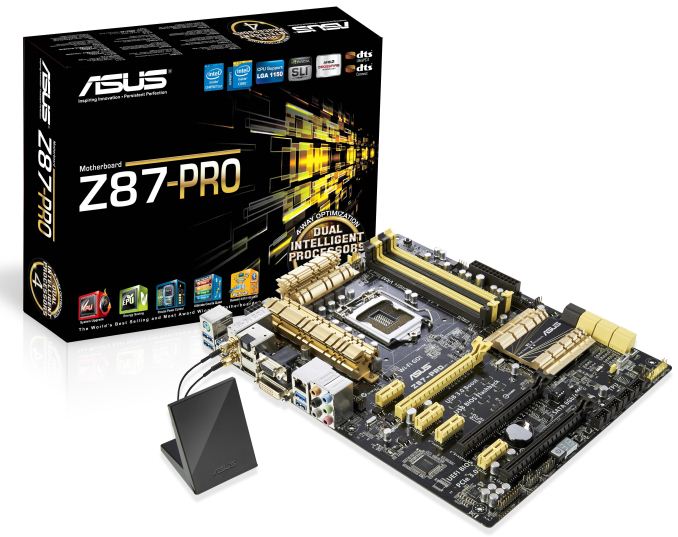Intel Z87 Motherboard Review with Haswell: Gigabyte, MSI, ASRock and ASUS
by Ian Cutress on June 27, 2013 8:00 AM EST- Posted in
- Motherboards
- Intel
- MSI
- Gigabyte
- ASRock
- Asus
- Haswell
- Z87
- Shark Bay
- Lynx Point
ASUS Z87-Pro Conclusion
The ASUS Z87-Pro sits between a rock and a hard place. ASUS is one of few motherboard companies that sit on the crest of innovation, coming up with new ideas that ultimately will filter through product ranges in each successive generation. Obviously the ones coming up with the ideas face the brunt of the cost, but unlike the medicine industry where markups are common if there is a sole solution to your problem, the motherboard market is cut-throat enough that the resellers, system integrators and end users dictate the pace of play with their wallet.
With all this being said it should be pointed out that the $200 price point is littered with competition, as we have already seen throughout this review. A motherboard manufacturer had to decide on layout, features, BOM costs and connectivity months ago – should they make a board designed to be at a higher price point and bring the cost down, or pull a motherboard up with a knockout blow on the credibility of the range. The ASUS comes into the market with a new style, new features, upgraded software and an incredibly nice to use BIOS. But at the same price point, other motherboards with more ports, more NICs, and 802.11ac exist. This is the hard point.
As far as testing the Z87 Pro, where have a large number of good points to discuss. The motherboard is efficient, boots fast, and has one of the better ALC1150 implementations despite not going the full way through to SupremeFX on the ROG side. Overclocking was also positive, and the ASMedia USB 3.0 ports reported similar speeds to the Intel points due to the lack of need for an ASMedia USB driver – the standard Intel one takes care of it.
The decision of ASUS to drop MultiCore Turbo from the main BIOS track is going to be a little strange, given that ASUS were the main protagonists in this field for the past two generations. MultiCore Turbo, when enabled, offers up to an additional 7% performance over a non-MCT enabled motherboard at stock settings and at full loading. The reasons given are simple: under stock conditions (i7-4770K in a case with the stock Intel cooler), a small (sub 5%) percentage of CPUs are forced to throttle due to heat generated. This is a combination of the Haswell architecture, the new stock Intel cooler, and features such as Adaptive Mode which struggle under artificial load. It kind of makes sense from a manufacturing point of view, but users who want MCT can follow the 3xxx BIOS track which has MCT enabled by default, or users can enable the option in the BIOS on the 1xxx track.
Another design choice made by ASUS is relating to the final PCIe slot. The board is wired up for PCIe 3.0 x8/x8 from the CPU and an additional PCIe 2.0 x4 from the chipset. ASUS have configured the chipset to output a total of eight PCIe 2.0 lanes, to power all the PCIe 2.0 x1 slots (of which there are four), various controllers and the final full length PCIe slot. However, in order to give everything wired up full bandwidth requires more than eight lanes, and thus various resources are shared. As a result, this final full length PCIe 2.0 runs at x1 by default, and requires a BIOS option to change it to x4, which in the process disables at least the ASMedia SATA 6 Gbps controller, reducing the total number of SATA 6 Gbps ports by two. This final PCIe slot can also be used in 3-way CrossFireX, but without careful consideration the performance difference between the final slot at x1 and x4 can be very large – in a couple of circumstances (Dirt3/Civ5) worse than just two GPUs on their own. For maximum GPU performance, the user would need to change the BIOS option to PCIe 2.0 x4. This is perhaps not painfully obvious unless the user has experienced lane bandwidth issues in the past; ideally I would like to see some software tool in the OS that could be enabled explaining the situation. Note this does not apply to GPUs specifically – PCIe 2.0 x4 RAID cards could also suffer in performance at x1 bandwidth.
Whenever a user considers purchasing this ASUS motherboard they should know that it is built to perform and has a great feature set, especially in terms of the BIOS and software but the additional hardware features such as BIOS Flashback and Fan XPert 2 are hard to ignore. The competition in the same price segment comes from companies that do not have that software backbone but are able to place more of everything and match the price of the ASUS. The ASRock Z87 Extreme6/AC is just one example of that competition that we have tested, and it is a task to decide between the strong build of the ASUS with DIP4/FanXPert2 against the dual Intel NIC/802.11ac/10 SATA 6 Gbps of the ASRock. Perhaps I am a little impressed by the way the latter has breached the price point, but the ASUS is a recommended motherboard for sure when considering any Z87 build. It only makes me wonder how other motherboards like the ASUS Z87 Sabertooth and ASUS Maximus VI Extreme perform – I hope we get them in to test.
For a great overall test, features and performance, I have no qualms in adding the ASUS Z87-Pro to our list of recommended motherboards and would like to give it our Silver award.
ASUS Z87-Pro
AnandTech Editor’s Choice Silver Award












58 Comments
View All Comments
Mr Perfect - Friday, June 28, 2013 - link
I was wondering the same thing. If all shipping Haswell boards have the faulty USB3, then this is a non-starter.Avalon - Thursday, June 27, 2013 - link
Is it just me, or are these boards too expensive?The Asrock Z77 Extreme6 is $155 on Newegg, $169 w/Thunderbolt. Asrock Z87 Extreme6 is $220-$20 MIR.
The Gigabyte Z77 UD3H is $140 on Newegg. Gigabyte Z87 UD3H is $180.
You get a couple extra USB 3.0 and SATA 6Gb slots and Haswell support, but I don't understand how that makes mid range boards at best command low high-end prices.
Mr Perfect - Friday, June 28, 2013 - link
My guess is it's just new vs old products at this point. The Z77 boards are old news and have had a year to fall in price. Meanwhile, the Z87s are shiny new toys that some people will pay a premium for.Rob94hawk - Thursday, June 27, 2013 - link
"As it stands the MSI BIOS looks like a higgledy-piggledy jumble to a new overclocker."Going from X38/775 to this I still haven't figured out what everything does.
nsiboro - Friday, June 28, 2013 - link
Ian, kindly provide info/links to ASUS Z87-Pro 3xxx series BIOS.The website product page (download) is only showing 1xxx series BIOS.
Thanks.
blackie333 - Friday, June 28, 2013 - link
Could someone please check/confirm whether USB 3.0 S3 wakeup bug also affects devices connected via additional(ASMedia 1074) onboard USB 3.0 hub ports available on Asus Z87-PRO stepping C1 board?Some people are suggesting that only USB 3.0 ports directly connected to Z87 chipset are affected by the bug.
chizow - Friday, June 28, 2013 - link
The PCIe lane config was the biggest deciding factor for me. I will only ever run 2-way SLI, so I wanted to maintain x8/x8 config for my 2x primary GPUs but wanted the flexibility of that 3rd slot for a PCIe SSD or PCIe PhysX card.Only the Asus and Gigabyte options offered that lane config, from what I saw both the MSI and Asrock designs go with x8/x4/x4 3.0 rather than x8/x8 3.0 + x4 2.0
The Gigabyte UD range was pretty vanilla, but I was OK with that, the Asus boards, although solid, offered a lot of features I would never need or use, like Wi-Fi.
I ended up with the Gigabyte Z87X-UD4 as it was cheaper than the comparable Asus offering Z87-Pro by quite a bit.
pandemonium - Saturday, June 29, 2013 - link
I love the thoroughness of these articles. Excellent job, guys!"ASUS’ reasoning is such that some of the Haswell i7-4770K CPUs, the ones that only just get into this category, will throttle the CPU speed when using the default Intel CPU cooler when MCT is enabled."
Who - buying a 4770K - will be using a stock cooler? What kind of rationality is that garbage? >.>
blackie333 - Saturday, June 29, 2013 - link
There can be some, maybe those waiting for a better cooler. But the question is why Intel is including cooler which isn't capable to cool the CPU and we still have to pay for it? It should be able to do it's job at least on default frequency.Anyway this problem is IMHO more an effect of Haswell heat transfer issue than poor quality of the stock cooler. If Intel could fix the CPU overheating issue the cooler should be good enough.
ven - Sunday, June 30, 2013 - link
why is that PCIe hub is present, many will prefer having a single device that will utilize all the bandwidth than having multiple devices choking with shared bandwidth, six SATA 6Gpbs is enough for most, with flex i/o and that hub removed gives x7 lanes and given this a Desktop board,msata will not be missed that much, so we can get tri-way SLI, i am little surprised that no manufactures choose this configuration.